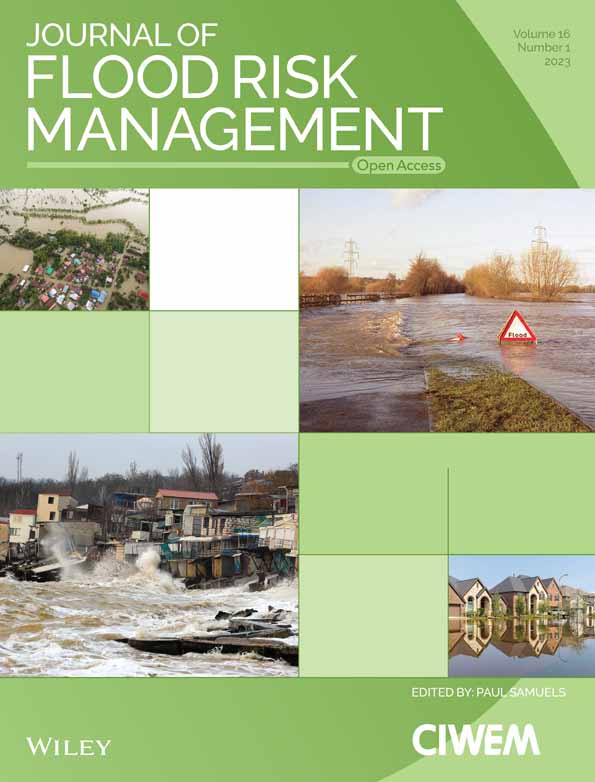Flood risk research for improving flood risk outcomes
Whenever I read the Journal of Flood Risk Management, I am always impressed by the diversity of papers and the value and opportunities that adopting a comprehensive approach to studying flood risk brings. I believe that, as a community, we have come a long way in flood risk research over the past decades and I want to use this editorial to briefly reflect on this and where we are in tackling the complex problems of flood risk and on developing scientific advancements, which improve outcomes for our at-risk societies. This is a pertinent question as we continue to see flooding occurring on the news or in our local communities.
White et al. in their 2001 paper identified four reasons why losses from natural hazards continue despite increasing knowledge and research: (i) knowledge continues to be flawed by areas of ignorance; (ii) knowledge is available but not used effectively; (iii) knowledge is used effectively but takes a long time to have effect; and (iv) knowledge is used effectively in some respects but is overwhelmed by increases in vulnerability and in population, wealth and poverty (White et al., 2001). More than 20 years on, we are still seeing losses from hazards such as flooding increasing, despite all the research and advances in these intervening years. I argue that some can be attributed to White et al.'s (2001) final two suggested reasons, and that increasing flood hazard, vulnerability and exposure are of course putting challenges on our existing knowledge and management approaches to flooding and there may be solutions from existing research studies that are still being implemented or for which we have not seen the effect. But as a community of researchers, we should reflect on how well we are doing on the first two.
So first, is our knowledge flawed by areas of ignorance? Flood risk research has evolved to tackle a broad range of topics and whilst there are gaps in knowledge, there has been significant progress over the past 20 years. The breadth of the scope of flood risk research has continued to expand away from efforts principally focusing on structural measures through engineering and physical science solutions. Comprehensive flood risk research now encompasses a wide range of disciplines and scientific domains including (but not limited to) engineering, statistics, geography, economics, psychology, political science, behavioural sciences, healthcare sciences and information and communication technology. But that does not mean that there are not still things we can learn and interdisciplinarity can only help us in finding a more complete picture and develop solutions that may have a greater impact. Indeed, with the changing hazard and more complex socio-economic issues, we may need to continue to revisit and adjust our applied knowledge concerning how best to tackle flood risk. This Issue of the Journal of Flood Risk Management (Volume 16, Issue 1—March 2023) exemplifies this multiplicity in evidence and the diversity of knowledge advancement and I herein focus on just two different examples, but of course I would commend all the contributions. Guo et al. (2023) combine several types of data and analysis to consider the effectiveness of inflatable dam structures for preventing flooding to a subway system. Combining laboratory tests and subsequent numerical modelling analysis, they have been able to analyse and isolate the key engineering features (e.g., air-inflated air pressure of the dam, anchoring depth, dam height) of the temporary structure as well as the conditions (e.g., flood type and forces) that it will effectively perform. Koma et al. (2023) adopt a more economic analytical approach to identify the optimum spatial construction of embankments considering the height of different sections and their priority of construction. Adopting an economic approach that focuses on which approach to construction is most efficient presents policymakers and flood risk professionals with evidence-based decision-making.
Second, reiterating the third deficiency highlighted by White et al. (2001), we need to question whether knowledge is available but not used effectively? This may be because those who might use the research are unaware of it, or the research findings are not presented in an accessible or usable way. An additional challenge is that an increase in the breadth of knowledge adopted and considered relevant is essential for a comprehensive picture of flood risk: it adds complexity, and subsequently challenges to its adoption. I therefore reiterate the viewpoints of my esteemed colleagues, Burrell Montz and Andrea Zischg in their recent editorials (Montz, 2021; Zischg, 2022) about the need to confront complexity in flood risk management research and consider the translation of studies to assist in their adoption into practice. Dewa et al. (2023) in their contribution to this Issue do just this and present a multidimensional framework for characterising, measuring and understanding community flood resilience in rural Malawi and integrate physical and socio-demographic factors. This approach provides ‘a context and hazard specific construct of community resilience’, which can be utilised by local flood risk managers for prioritising actions.
Flood risk researchers need to continue the conversation and engagement with policymakers, flood practitioners and at-risk societies to identify gaps in knowledge that research can fill and work with others to convert existing knowledge into action. Indeed, we would welcome more contributions to the Journal, which focus on the translational challenges to ensure that flood risk research can have the widest impact and be transformed into positive action for society.
Lastly, the Associate Editors and I would like to acknowledge, with much gratitude, the support and commitment the Journal receives from all our peer reviewers, who make time voluntarily to read and comment upon the manuscripts we receive. Thank you all; without your contributions, it would not be possible to publish the Journal of Flood Risk Management.




